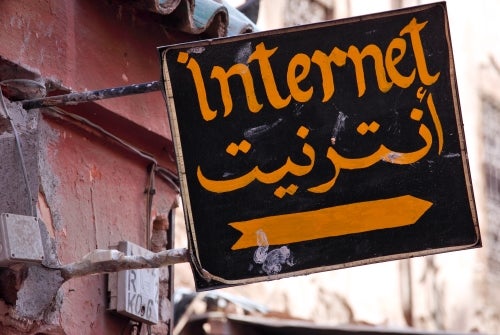 It may not be surprising that the number one country in the world with the most Youtube users is Saudi Arabia. But what is surprising, with Youtube’s overall global viewership predominantly male, is that the majority of Youtubers in Saudi Arabia are women. And even more surprising, is that the most-watched Youtube content category in Saudi Arabia is education.
It may not be surprising that the number one country in the world with the most Youtube users is Saudi Arabia. But what is surprising, with Youtube’s overall global viewership predominantly male, is that the majority of Youtubers in Saudi Arabia are women. And even more surprising, is that the most-watched Youtube content category in Saudi Arabia is education.
For Saudi women, Youtube provides them with educational sources that might not otherwise be readily available to them. Technology empowers them with access to knowledge and interconnectivity.
Across the Arab world, technology is helping people solve economic problems, as well as create startups, in unprecedented ways they couldn’t have dreamed of 20 years ago. Christopher Schroeder, venture capitalist and author of " Start-Up Rising: The Entrepreneurial Revolution Remaking the Middle East" calls it "a quiet revolution" that is changing the face of the region.
During a recent talk, Schroeder said that what really moved him during his time in the Middle East was how people with even the most basic technology like "dumb" (non-smart) phones used them in ways to solve immediate social and economic needs.
This ranges from, simply, craftswomen in Cairo using very basic mobile phones to manage deliveries and double their sales, to souq.com, the Arab Amazon.com, fulfilling online shopping needs, which is now worth over a billion dollars and employs thousands.
But the bigger, more subtle take-away that comes from this technological revolution is that we have to stop seeing people as development problems to be solved, and start seeing them as assets. The best answers to development problems come from the people on the ground who are actually living them. They just need the tools to tackle them – not solutions from top-down organizations. Interconnectivity through ubiquitous mobile technology use helps to unleash the best minds and the best assets; it gives people not just access to all information known to mankind through the internet, but also the ability to collaborate beyond any space limitations.
 One powerful example of local solutions driven by technology can be seen in education. More money is spent on public education in the Arab world (19% of total government spending on average) than in South East Asia and other regions (the global average is 14%). However, the results of that education aren't that good, especially compared to those regions. Twenty five percent of students are illiterate, and those who are literate, attend schools with overcrowded classrooms that provide rote learning at best. And in Cairo alone, 3.5 billion dollars are spent every year on supplementary education! So not only is public education below par, but it becomes apparent that rich people resort to private tutors to get a decent education … where does that leave people who can't afford to pay for supplementary education?
One powerful example of local solutions driven by technology can be seen in education. More money is spent on public education in the Arab world (19% of total government spending on average) than in South East Asia and other regions (the global average is 14%). However, the results of that education aren't that good, especially compared to those regions. Twenty five percent of students are illiterate, and those who are literate, attend schools with overcrowded classrooms that provide rote learning at best. And in Cairo alone, 3.5 billion dollars are spent every year on supplementary education! So not only is public education below par, but it becomes apparent that rich people resort to private tutors to get a decent education … where does that leave people who can't afford to pay for supplementary education?
So, some young entrepreneurs saw this problem and built “ Nafham” following the model from Khan Academy, a site where Egyptians can submit educational videos to the curriculum in Cairo. Instead of taking on education reform, institutionally or politically, which these entrepreneurs knew wasn’t their forte, they found a way of empowering students through technology, through videos and texting updates, and allowed them to circumvent the problem of investing in private tutors .
And Schroeder highlights the great multiplier effect that comes with widespread technology & internet access in the Arab world. In 9 months, over 25 thousand videos were uploaded to Nafham and there were over 2.5 million video views in Egypt.
Technology is now deeply embedded in the daily life of Arab youth, and it is being used for many success stories like Nafham. Internet access is empowering young people to come up with their own solutions to the problems they face.
Development institutions can contribute to that empowerment, but it will require a change of mindset. Shroeder quoted an Egyptian woman who changed his perspective. She said, “Top- down organizations, which is most development or aid organizations, see the issue like this: people are problems. They have to be solved.”
However, “bottom-up” mindsets see that people are assets. In any development challenge, the people most affected by them need to be co-authors of any solution. Development institutions need to stop seeing development projects in the frame of "sponsors" and "beneficiaries," and instead recognize that people are the real solution.


Join the Conversation
Admiring the commitment you put into your website and in depth information you present. It's awesome to come across a blog every once in a while that isn't the same unwanted rehashed information. Great read! I've bookmarked your site and I'm including your RSS feeds to my Google account.
My spouse and I absolutely love your blog and find almost all of your post's to be precisely what I'm looking for. Would you offer guest writers to write content available for you? I wouldn't mind publishing a post or elaborating on many of the subjects you write regarding here. Again, awesome site!
This was very insightful, specially that part about video consumption in Saudi Arabia. And yes I agree that people are the real solution.
Lovely blog!!